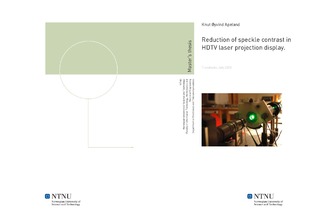| dc.description.abstract | Abstract In this thesis the focus has been on laser speckle. It is done in collaboration with poLight. They are developing a projector, where laser light is the source of illumination. In such projectors, laser speckle degrades the image quality. The aim of this project is to construct a speckle reduction device to be used in the laser projector. The theory covers a description of laser speckle, how to reduce the speckle contrast, and five methods to so. We explain why speckle arises and which parameters we can manipulate to reduce the speckle contrast. The five speckle reduction methods included in this thesis are; vibrating diffuser, slowly moving diffuser, Hadamard matrices, scattering tube, and vibrating mirror. Large vibrational motions are unwanted, considering the size of the device, generation of noise, and problems with alignment of the optical components in the projector that this would lead to. The quality of the laser beam is prominent in order to produce a sharp image, thus the use of diffusers with large scattering angles is not a good solution. The scattering tubes, designed by poLight, are tubes filled with micro pearls in a polymer gel. The size of the pearls decides the nature of the scattering. Larger pearls will give less back scattering and more light transmitted in the forward direction. If the tubes are rotated in a well balanced device we can avoid generating vibrations. The Hadamard matrices is the only one of the five methods which is not based on a motion. The challenge is to find a SLM to implement the matrices. It requires a low response time in order to present enough matrices during the exposure time of the eye. The laboratory setup we use to measure the speckle contrast is an improved version of the setup constructed in the specialisation project. A screen was removed from the old setup, and the speckle is now imaged directly from the speckle reduction device. The measured speckle reduction is thus due to the device alone, and not affected by the screen. The results were reproducible and in agreement with what we expected. We implemented a vibrating diffuser, both the single and the slowly moving. A piece cut from a plastic bag and some Scotch Magic tape were used as diffusers. The tape is the strongest diffuser and gives the lowest speckle contrast, however, it also has the largest scattering angle. The single tape diffuser reduced the speckle contrast to $C = 0.112$. With two tape difusers in series the intensity in the images becomes too low to exploit the dynamic range of the CCD sensor. The result is a higher calcualted speckle contrast with two diffusers, $C=0.131$, even though it ought to be smaller. We tested five prototypes of the scattering tube with different concentrations. The tube with the highest concentration has the highest speckle reduction abilities. It also has the strongest scattering effect. The scattering is less than with the tape diffuser, and so is the speckle reduction. The speckle contrast is reduced to $C=0.320$ when the tube is rotated, and to $C=0.389$ when it is vibrated. The tubes was also tested in series with a ground glass. The ground glass acted as a second diffuser. In this setting, vibration and rotation of the tubes reduced the speckle contrast equally, $C approx 0.283$ From the measured speckle contrast of the diffusers and tubes in stationary conditions, a polarization analysis should show a depolarization of the laser beam. This were the case only for the plastic diffuser. It is assumed that the error lays with the polarization analysis. There should be a depolarization in the tape and a partial depolarization in the tubes. A calculation of the speckle size was performed as well. Based on the theory we expected the size of the speckle grains to be $sigma_s = 37.77~mu m$. From the Fourier analysis of a speckle image from the setup we calculated the speckle size to be $sigma_s = 5.35$~mm, which is approximately 140 times bigger. The expected speckle size is too small, because we did not take into account a small magnification in the setup. The Fourier analysis of discrete and limited sets of data points is probably the main explanation of the difference, but a more thorough study is needed. | nb_NO |

